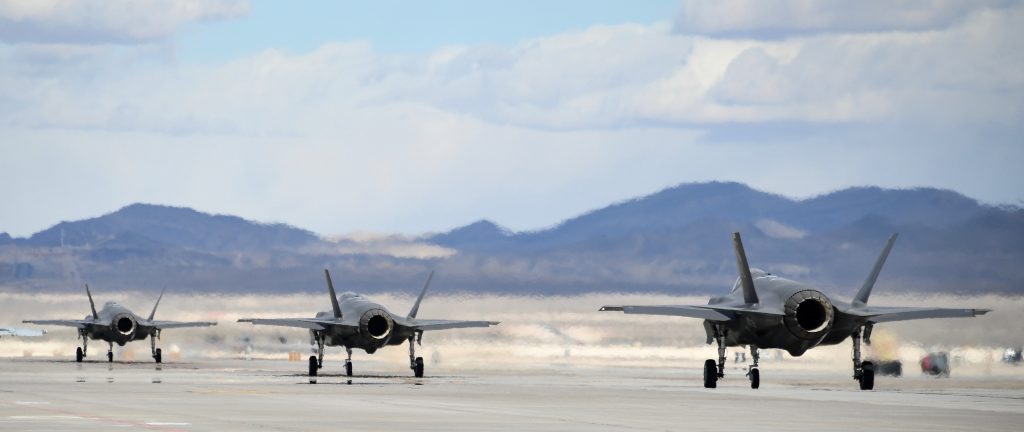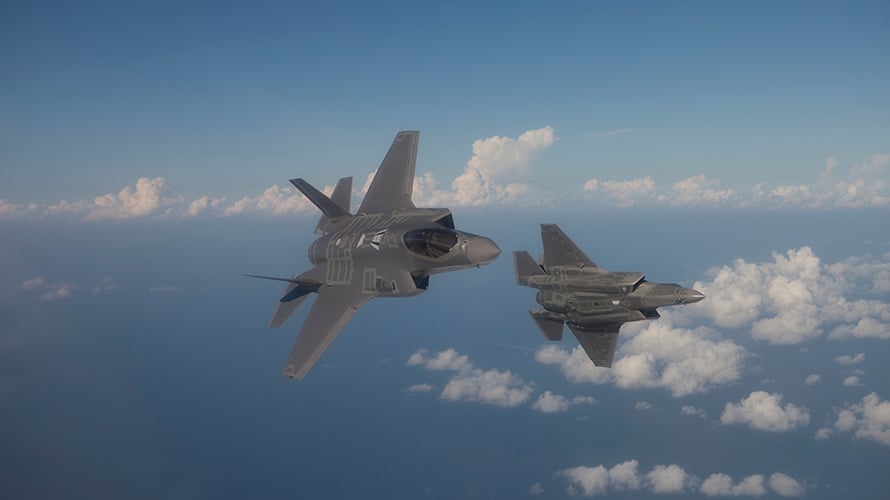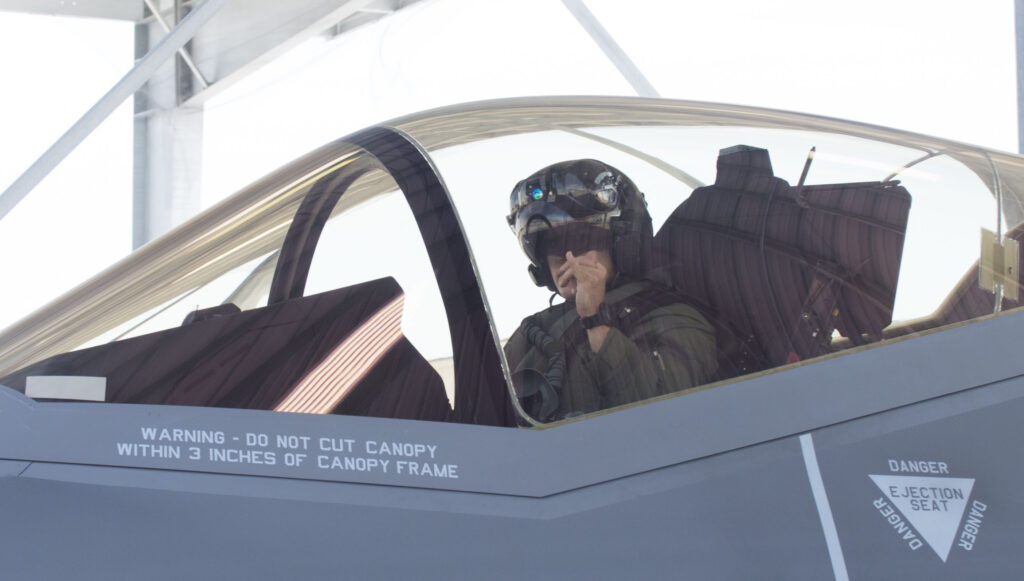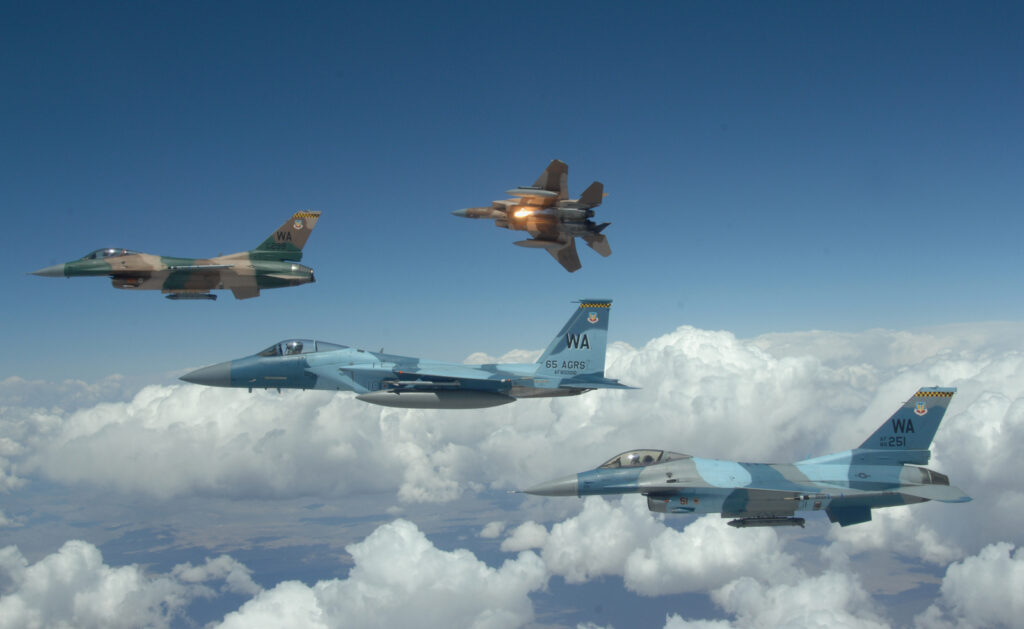Red Flag 2019: First Great Power Air War Test In Years
Posted on

F-35As from the 388th and 419th Fighter Wings fly over the Utah Test and Training Range.
The National Defense Strategy warns of a new era of potential conflict with revisionist powers Russia and China. The Air Force just offered a preview of that lethal battlespace.
After refueling at night over a southern-Nevada dust bowl called Texas Lake, scores of U.S. and coalition warplanes crossed into contested air space on a mission to suppress state-of-the-art enemy air defenses. The formation was soon bombarded with warning signals as radars of advanced surface-to-air (SAM) missile batteries with the reach of Russia’s S-300 and S-400 air defense systems switched on.
Electronic jammers struck as fighter pilots tried to communicate with an E-8 Joint STARS command-and-control aircraft; rear-area command cells had satellite linkages disrupted by cyberattacks. Starbursts of surface-to-air missile launches flashed on the ground below, and cockpit alarms warned that the formation was being painted with multiple radars from enemy aircraft with paint schemes and capabilities designed to replicate the likes of the advanced Sukhoi Su-30 Flanker fighters in the arsenals of both Russia and China.
Because this was the final mission in a three-week Red Flag exercise, however, the “Blue Force” pilots did not panic when confronted with a coordinated attack by Red Force Aggressor Squadrons operating in all domains – air, ground, space and cyberspace. Working in tandem, fifth generation F-22 Raptors and F-35 Lightning aircraft escorting the Blue Force formation exploited their stealth and speed to close quickly with the most immediate threats. The F-35s used their unprecedented sensor suites to gather, fuse data and distribute a common picture of the threat array to other aircraft. Fourth generation F-15s, F-16s, F-18s and British Eurofighters used that targeting data to launch beyond-visual range missiles and bomb strikes on SAM sites as strike aircraft proceeded successfully to other enemy targets. The simulated warfare felt surprisingly real in the cockpits of warplanes traveling at supersonic speeds.

F-35As of 388th Fighter Wing’s 4th Fighter Squadron at Red Flag 2019, Nelllis Air Force Base, Feb. 6.
In that Red Flag exercise completed last month, 2,900 personnel from 39 separate units participated in 26 distinct missions and flew 95 aircraft from the U.S. Air Force, U.S. Navy, Royal Air Force and Royal Australian Air Force. Everthing gleaned from intelligence about China and Russian forces was thrown at the allied pilots.
“On the last week of a Red Flag exercise we really throw everything we have at the Blue Force and replicate the toughest adversary possible, because that’s what they will face in a high-end fight against a ‘near peer’ competitor,” said Col. Travolis “Jaws” Simmons, commander of the 57th Adversary Tactics Group, the umbrella organization for all the Aggressor Squadrons that operate out of Nellis Air Force Base, home to Red Flag exercises and the Air Force’s elite Fighters Weapons School. “We turn the temperature way up in those final missions, because we want the Blue Force pilots and operators to leave Red Flag knowing that they took our best punch, and to take that confidence into combat if and when the time comes. That’s our ideal goal.”
Simulated Combat
Red Flag grew out of the Air Force’s experience in Vietnam, when studies indicated it took a pilot roughly 10 combat missions to become experienced enough to have a reasonably good chance of survival. Beginning in 1975, the Air Force began spending hundreds of millions of dollars on simulated combat exercises to give its pilots that experience before they went to war.
For pilots without combat experience, Red Flag still represents not only the first time they witness an entire Blue Force strike package of many different types of aircraft assembled in the air, but also the first time they fly against determined opponents mimicking adversary tactics and capabilities. Pilots with ground-attack missions have to coordinate attack routes and mid-air refueling schedules with other attack cells, everyone relying on friendly air superiority fighters and directions from command-and-control aircraft.
For U.S. and coalition air forces that have spent most of the last two decades conducting combat missions against an enemy without airplanes as part of the war on terror, it was an opportunity to become acquainted with the far more challenging scenario of fighting in a high-intensity battlespace against a “near peer” competitor like Russia or China.
Brig. Gen. Robert Novotny, commander of the 57th Wing at Nellis Air Force Base, oversees Red Flag exercises. “For the first time in a long time, the National Defense Strategy has prioritized the high-end threat, which tells wing commanders throughout the Air Force, who for years have been most concerned with preparing for their next counter-terrorism deployment, that they now need to rebalance a bit and focus on the high-end fight against our toughest potential adversaries,” he said in an interview. “That’s the fight we have always prided ourselves on replicating at Red Flag.”
Over the years Red Flag has expanded from its original focus on combat survivability and the air-to-air mission, Novotny notes, to incorporate training in all of the Air Forces five core functions – air superiority, air-to-ground strike, ISR (Intelligence, Surveillance and Reconnaissance), command-and-control (C2), and personnel rescue and recovery. All of those missions are conducted against a dedicated sparring partner in the Aggressors, unrivaled experts in enemy weapons systems and tactics, and train so much in force-on-force exercises that they punch well above their weight in the air.
“A lot of our airmen have had experience deploying downrange to places like Afghanistan, Iraq and Syria, which gives them familiarization with employing their weapons systems against a real enemy, but those operations have been conducted in a very permissive environment with uncontested air superiority and freedom of movement in all domains,” said Novotny. By contrast at Red Flag, he noted, U.S. and coalition operators confront an opponent who fights back in all domains and can replicate the most advanced weapons systems and platforms available around the world, from redundant, integrated air defense systems using fiber optics like China fields in the Pacific and Russia operates in Kaliningrad, to advanced fighters like the twin-engine Russian Sukhoi Su-30 Flanker, which has been exported to China and India.
The latest exercise also incorporated some of the political ambiguity, Identify Friend or Foe (IFF) challenges, and proxy war protocols that Air Force pilots have encountered in Syria, where they share the battlespace with Syrian, Iranian, Turkish, Israeli and Russian forces, as well as allied and adversarial paramilitaries and non-state actors.
“On top of those ‘rules of engagement’ challenges, Blue Forces at Red Flag are contested in the air, subject to Aggressor missile strikes on their operating and logistics bases, and hit with cyberattacks on their command-and-control and space systems designed to disrupt satellite communications and GPS [Global Positioning System] targeting,” said Novotny, who notes that the 64th Aggressor Squadron is flying double the number of sorties it logged just last year. “So the Aggressors are a marquee feature at Red Flag, and their mission of knowing, teaching and replicating enemy capabilities is critical to what we do.”
Building Blocks
In keeping with the focus on improving combat survivability for air crews, Blue units typically send their least experienced pilots and operators for the premiere training. In the recently completed 19-1 Red Flag exercise, for instance, the 4th Fighter Squadron of the 388th Fighter Wing stationed at Hill Air Force Base, Utah, sent a dozen pilots who had never been to Red Flag nor seen combat in the squadron’s F-35 fighters, and four that were straight out of initial pilot training.
At Nellis, Red Flag officials also adopt a “building block” approach with visiting units. From tragic experience with numerous deadly plane crashes in the early years of Red Flag, they know that throwing too many challenges, too soon, at inexperienced fighter pilots can overwhelm them. “Typically in the first week, the Blue team has to crawl before they can walk, and it takes them time to learn the strengths and weaknesses of friendly weapons platforms that they don’t normally see at home base, and how to integrate them all effectively into a single strike package,” said Simmons of the 57th Adversary Tactics Group. “After what is usually a rough first week, Blue team’s learning curve goes up quickly, and the Aggressors dial it up and become more dynamic and adaptive in how we respond to their operations.”
The primary tool in that learning process, and an essential element of Red Flag’s culture of constant self-improvement, is what Nellis officials call “the Great Unveiling” – hours-long and brutally honest after-action debriefings following each mission. Participants famously leave their rank at the door of the debriefing amphitheater, and with the aid of video screens and big data collected at the heavily instrumented Nevada Test and Training Range, Red and Blue force pilots and operators calculate hits, misses and casualties. They also discuss which “audibles” called in the air worked, and those that backfired. Often the picture of the air battle that emerges from that comprehensive analysis is far different than the one pilots perceived from their cockpits.
“The debrief is where pilots find out if they really did as good as they think, commanders included, and thus it’s where most of the learning occurs at Red Flag,” said Simmons. Debriefs are never unprofessional, he said, but the conversations can get heated. “Frankly, you have a lot of pilot egos in that room, and nobody wants to stand on that stage embarrassed at becoming the `DFP’ – the Debrief Focal Point. The DFP is the main thing that went wrong on the mission, and you might spend two hours analyzing and talking about that one mistake to make sure it never happens again in actual combat. That can require speaking truth to power. So the debrief is our secret sauce, and part of the beauty of Red Flag.”
Outmatched Aggressors
The last mission of the 19-1 Red Flag was an advanced suppression of enemy air defenses at night. By the third week, the Blue Force had solved the puzzle of weapons system integration, designing a strike force echelon able to exploit the strengths and mask the weaknesses of each individual aircraft. The biggest learning curve in that process was understanding how fifth generation aircraft can use their unmatched stealth, speed and sensor capabilities to increase the effectiveness and survivability of the entire strike package.
“The F-22s and F-35s were able to use our stealth and speed to get closer to the threats and soften them up, collect a lot of information about the battlespace, and then use the F-35’s data link in particular to communicate that picture to the rest of the strike package so that fourth generation aircraft like the F-15s and F-16s could attack those targets with their missiles and bombs,” said Lt. Col. Yosef Morris, commander of the 4th Fighter Squadron of F-35s. “While we struggled at that mission in the first week, by the last week we broke down the biggest integrated air defense system the Aggressors could field, and allowed our strike aircraft to successfully get through to their targets. So we left Red Flag highly confident in our ability to operate in a high-threat environment against a near-peer competitor, both in terms of operating our own aircraft and in integrating them into a larger strike package. You can’t get a confidence boost like that anywhere else in the world other than actual combat.”
The combat edge of stealthy fifth-gen aircraft in high-intensity air combat, and their force multiplying effect when carefully integrated in a “high-low” mix with fourth generation fighters that may have superior endurance and weapons carrying capacity, is one of the prime lessons of recent Red Flag exercises. In last year’s simulations, F-35s have reportedly achieved a kill ratio against Aggressors as high as 15 to 1.
“The F-22 and F-35 have complicated our job here at Red Flag, because their speed, stealth and sensor fusion capabilities make it difficult for our Aggressors to really challenge and push them,” said Brig. Gen. Novotny. Nellis officials are working hard to modernize the air defense systems and Aggressor Squadron capabilities at Red Flag so they can keep pace, he noted, but it’s not a fair fight. “I’m an F-15 pilot with over 3,000 hours in the air, so I’m pretty cocky about my capabilities, but I sure wouldn’t want to go to war against a high-end threat without those fifth generation aircraft flying alongside.”
(We have asked for the F-35’s kill ratio for this Red Flag and have not yet received it. The Air Force increasingly argues that the kill ratio isn’t as relevant for the F-35 as in days past because of the key role it plays in providing targeting information to fourth generation aircraft. The argument pretty much boils down to: who killed the enemy — the plane that detected it and targeted it or the plane that actually fired the weapon that killed it. We’ll take both sets of data, with the needed caveats. The Editor.)
Subscribe to our newsletter
Promotions, new products and sales. Directly to your inbox.



